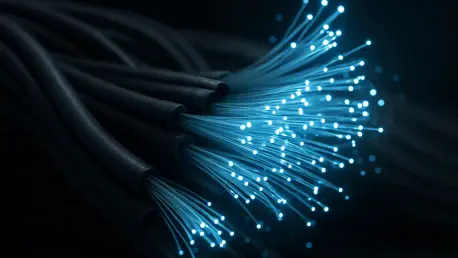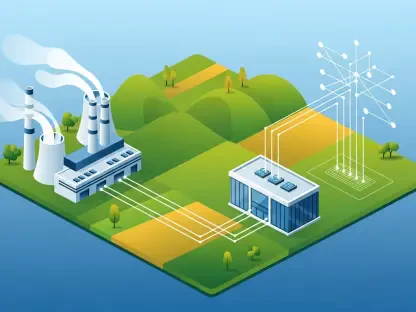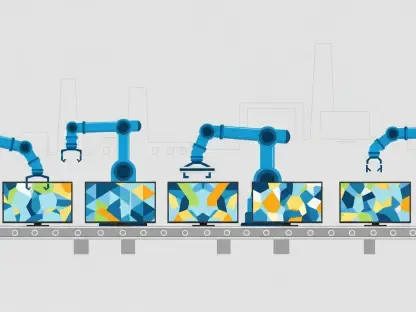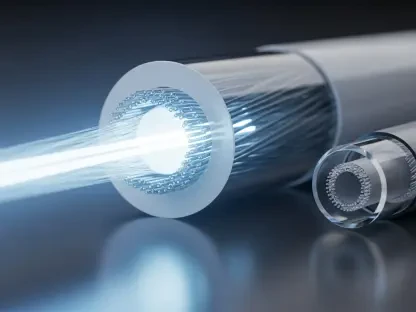The advent of distributed fiber-optic sensing (DFOS) technology has prompted a significant shift in how oil and gas pipelines are monitored. Traditional inspection methods, often plagued by limitations such as intermittent checks and human error, have given way to a more continuous and reliable form of scrutiny that is both real-time and remotely accessible. This innovation stems from the strategic deployment of fiber-optic cables, which permits immediate detection of irregularities, including leaks. The engineering behind DFOS allows for a level of vigilance that, when compared to conventional systems, can lead to faster responses and potentially fewer environmental and safety hazards. Given the risks associated with pipeline integrity in difficult terrains or remote locations, the importance of such real-time monitoring cannot be overstated.
Technological Integration and Testing
Experimental Design and Methodology
The potential of DFOS for pipeline monitoring was rigorously examined through a thoughtfully structured study involving the internal adjustment of fiber-optic cables within standard industry pipelines. This setup used a test pipeline 21 meters in length, possessing a 4-inch internal diameter and included an adaptable section to simulate a variety of scenarios. The cable deployment methods were varied, involving both external and internal positioning to evaluate the efficacy of each. The primary aim of these tests was to simulate potential leak conditions by creating holes of varying sizes and orientations, paired with different gas velocities.
The impact of gas velocities and the cable properties on detection sensitivity was closely monitored during test runs. Gas velocities tested ranged from 2 to 18 m/s, aiming to mirror a broad spectrum of possible operational conditions. Detection was mainly predicated on identifying vibration anomalies at leak sites, demonstrating the adeptness of fiber-optic cables in spotting issues with pinpoint precision. Notably, internal cables exhibited superior sensitivity to leaks compared to their external counterparts, as the physical properties of softer and lighter cables allowed for enhanced responsiveness to disturbances.
Key Findings and Implications
Results from the experiment underscored the critical role of internal cable deployment, which provided more reliable detection capabilities compared to external methods. The intrinsic advantage of internal placement lies in its immediate proximity to the source of potential leaks, facilitating a faster and more precise detection process. The experiment revealed an impressive correlation between leak size and detection efficacy, with larger holes and faster gas flows yielding higher detection rates. These findings suggest a pivotal opportunity to enhance pipeline safety protocols, replacing or augmenting traditional monitoring approaches with more advanced solutions.
The implications of these findings extend beyond mere detection. The produced data lays the foundation for a new standard of pipeline safety, addressing the dire need for enhanced operational reliability. Internal fiber-optic cable deployment not only enhances the sensitivity and accuracy of leak detection but also sets the stage for predictive maintenance strategies, potentially transforming how pipeline integrity is managed industry-wide. This transition holds promise for significant environmental and economic benefits, reducing the likelihood of catastrophic failures and resource waste.
Real-World Applications and Challenges
Implementation Challenges
Adopting DFOS in practical contexts presents several challenges, ranging from the technical to the logistical. While the benefits of internal fiber-optic deployment are palpably clear, actualizing this transition requires overcoming initial hurdles. Installation costs and the need for technological upgrades in existing pipeline infrastructures are among the primary concerns. Furthermore, the industry needs to establish standardized regulations and guidelines to ensure seamless integration and operation. As pipelines differ in construction and material, the process of retrofitting existing systems can be daunting, necessitating careful planning and execution.
Stakeholders also face the task of upskilling personnel to ensure workers are proficient in operating and maintaining these advanced systems. Adopting new technologies mandates an industry-wide paradigm shift, sparking a demand for specialized training programs. Despite these challenges, the promise of improved safety and efficiency provides a compelling incentive for investment and innovation. With proper planning and continuous technological advancements, the deployment of DFOS in pipeline monitoring systems can become a staple of future safety and operational strategies.
Future Prospects and Considerations
Looking ahead, the successful integration of DFOS into pipeline monitoring heralds a promising future for the oil and gas industry. Embracing this technology not only seeks to address immediate safety concerns but also aligns with broader trends towards digital transformation. The potential for integrating DFOS with existing data systems further opens the door for predictive analytics, advancing from reactive to proactive pipeline maintenance solutions. This proactive approach can optimize operational efficiency while minimizing ecological and financial risks.
As the oil and gas sector continues evolving, the role of advanced monitoring technologies is set to become more pronounced. DFOS contributes to a shift towards more intelligent infrastructure, poised to adapt to ever-changing operational and environmental conditions. By harnessing the potential of these systems, industries can expect a more secure and efficient management of critical resources. The long-term perspective envisions a future where unforeseen failures are rare, and real-time data-driven decision-making becomes the norm.
A Path Towards Enhanced Pipeline Integrity
The potential of Distributed Fiber Optic Sensing (DFOS) for pipeline monitoring was thoroughly explored in a study that meticulously adjusted fiber-optic cables within standard industry pipelines. A test pipeline, 21 meters long with a 4-inch diameter, was designed with an adaptable section to recreate various scenarios. The study implemented both external and internal cable placements to assess their effectiveness. The core goal was to mimic leak conditions by creating holes of different sizes and orientations, combined with varied gas flow rates.
Gas velocities ranged from 2 to 18 m/s, representing a wide array of operational scenarios. The focus was on detecting vibration anomalies at leak points, showcasing the fiber-optic cables’ precision in identifying and pinpointing leaks. Internal cables, positioned inside the pipeline, demonstrated greater leak detection sensitivity than external ones. This heightened sensitivity is attributed to the softer and lighter physical characteristics of internal cables, which enable them to respond more effectively to disturbances within the pipeline environment.









